#wildlife: belgium
Explore tagged Tumblr posts
Text

Carabus auronitens, a ground beetle, in Brussels, Belgium
by Frank Vassen
#carabus aurinitens#ground beetles#beetles#carabus#carabidae#coleoptera#insecta#arthropoda#wildlife: belgium#wildlife: europe
166 notes
·
View notes
Text

“Pen and inkwell”
“I'm lucky enough to live close to the Camargue, a perfect place to photograph pink flamingos (Phoenicopterus roseus). This image shows a flamingo searching for prey in a muddy pond. The photograph was taken late in the day, with light cloud cover. Positive exposure compensation produced the high-key effect. The result reminded me of a paintbrush covered in ink.”
by Jonathan Lhoir (Belgium).
2023 European Wildlife Photographer of the Year
#jonathan lhoir#photographer#belgium#pen and inkwell#carmargue#pink flamingos#phoenicopterus roseus#flamingo#bird photography#european wildlife photographer of the year
242 notes
·
View notes
Video
Bengal Tiger - Pakawi Park by Mandenno Photography
#Bengal#Tiger#bengaltiger#Bengaalse#TIjger#Animal#Animals#Animalplanet#animalphotography#Nature#NatGeo#Natgeographic#Natgeowild#wildlife#bbcearth#BigCat#Cat#feline#PakawiPark#Belgie#Belgium#MandennoPhotography#flickr
70 notes
·
View notes
Photo


Pairi Daiza, Belgium
#5#nature#landscape#curators on tumblr#landscape photography#photography#nature photography#red panda#mine#summer#belgium#pairi daiza#flowers#pink#white#wildlife#zoo#set#photoset
1K notes
·
View notes
Text

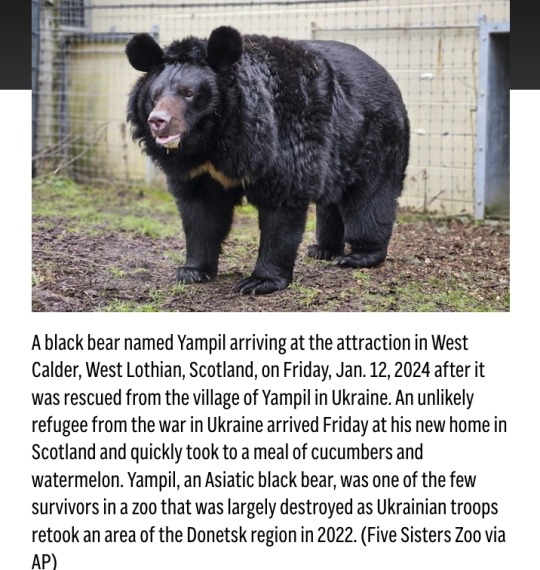
By Brian Melley, AP News
13 January 2024
LONDON (AP) — An unlikely refugee from the war in Ukraine — a rare Asiatic black bear — arrived at his new home in Scotland on Friday and quickly took to a meal of cucumbers and watermelon.
The 12-year-old Yampil was named for a village in the Donetsk region where he was one of the few survivors found by Ukrainian troops in the remains of a bombed-out private zoo.
Yampil, who had previously been called Borya, was discovered by soldiers who recaptured the devastated city of Lyman during the Kharkiv counteroffensive in the fall of 2022, said Yegor Yakovlev of Save Wild, who was among the first of many people who led the bear to a new life.
The bear was found in a menagerie that had long been abandoned by its owners.
Almost all the other animals had died of hunger, thirst or were struck by bullets or shrapnel and some were eaten by Russian troops.
Yampil narrowly missed the same fate, suffering a concussion from a projectile that landed nearby.
“The bear miraculously survived,” said Yakovlev, also director of the White Rock Bear Shelter, where the bear recovered.
“Our fighters did not know what to do with him, so they started looking for rescue.”
What followed was an odyssey that your average bear rarely makes, as he was moved to Kyiv for veterinary care and rehab, then shipped to a zoo in Poland, then to an animal rescue in Belgium, where he spent the past seven months, before landing in the United Kingdom.
Brian Curran, owner of Five Sisters Zoo in West Calder, Scotland, said his heart broke when he learned of the plight of the threatened Asiatic black bear.
“He was in terrible condition; five more days and they wouldn’t have been able to save him,” Curran said. “We were just so amazed he was still alive and well.”
The bear was skinny but not malnourished when he was found, said Frederik Thoelen, a biologist at the Nature Help Center in Belgium.
He now is estimated to weigh a healthy 440 pounds (200 kilograms), Thoelen said.
The nature center in Belgium, which usually treats injured wildlife and returns them to their natural settings, has taken several animals rescued from the war in Ukraine, including a wolf, a caracal cat and four lions, though those animals had not experienced the ordeal Yampil endured.
It was remarkable how calm Yampil was when he arrived in Belgium, Thoelen said.
The bear was trained in the past two weeks to move from his enclosure to the crate that would transport him across Belgium to Calais, France, then across the English Channel on a ferry to Scotland.
Pastries from a local bakery were used for good measure to lure him Thursday into the cage, where he was sedated for the journey.
“We want to use the food that he likes most, and for most bears — and for people also — it’s sweet, unhealthy foods,” Thoelen said.
Thoelen had a sense of the bear’s weight as he drove the crate to the port.
“Every time when we had a red light or a traffic jam, when the bear moved a little bit, you could feel the van moving also,” he said.
“You could feel it was a heavy animal in the back of the car.”
Yampil arrived at the zoo about 15 miles (25 kilometers) west of Edinburgh and immediately made himself at home.
He feasted on cukes — said to be his favorite food — and melon, said Adam Welsh, who works at Five Sisters.
The Asiatic black bear is listed on the International Union for Conservation of Nature’s Red List of Threatened Species as vulnerable to extinction in the wild, where it can be found in central and southern Asia, Russia, and Japan.
It’s known for the distinctive white crescent patch on its chest that gives it the nickname moon bear. It can live for up to 30 years in zoos.
It’s not clear if the bear will go into hibernation. The winter has been warmer than usual but colder days are on the horizon.
The zoo has other bears, but Yampil is the only Asian bear and unique in other ways.
“We’ve had circus bears, for example, that have been rescued,” Welsh said.
“We’ve had bears rescued from places like roadside restaurants where they’ve been used as kind of roadside attractions and been kept in subpar conditions. But this is the first time that we’ve worked with an animal that’s been rescued from a war zone.”
youtube
Scottish zoo welcomes black bear which survived war in Ukraine
13 January 2024
🖤🐻🤎
#Asiatic black bear#Ukraine#Scotland#Yampil#Borya#Save Wild#White Rock Bear Shelter#Five Sisters Zoo#Nature Help Center#Belgium#Poland#International Union for Conservation of Nature’s Red List of Threatened Species#moon bear#save animals#protect wildlife#threatened species#refugee bear#private zoo#Youtube
187 notes
·
View notes
Text

African Lion
Pakawi Park - Belgium
📸 by @mandennophotography
39 notes
·
View notes
Video
Siberian Tiger - Pairi Daiza by Mandenno Photography
#Siberian#Tiger#siberiantiger#siberische#TIjger#Animal#Animals#Animalplanet#animalphotography#Nature#NatGeo#Natgeographic#Natgeowild#wildlife#bbcearth#BigCat#Cat#feline#PairiDaiza#Belgie#Belgium#MandennoPhotography#flickr
20 notes
·
View notes
Text

young coot in the marsh
#coot#rallidae#birds#wildlife#photography#birds of the marsh#reflections in water#cute animals#baby animals#animal kingdom#nature#bourgoyen#ghent#flanders#belgium#original photographers#photographers on tumblr#lensblr#original photography#pws
25 notes
·
View notes
Text

0 notes
Text

‘A fawn is carried to safety in Mehaigne, Belgium. The man doing the carrying is Cedric Petit, founder of Sauvons Bambi (Let’s Save Bambi), an organisation that rescues deer, hares and ground-nesting birds that have hidden under long grass in fields and meadows that are about to be ploughed up by farmers. Sauvons Bambi uses drones equipped with heat-sensitive cameras to find the animals; volunteers then move them to the edge of the field, where the mother can find them again. This year it has saved 834 fawns across Belgium and Luxembourg
Photograph: John Thys/AFP/Getty Images’
-
how wonderful!
0 notes
Text
youtube
#mantis#praying mantis#scorpion#australia#argentina#bangladesh#austria#belgium#brazil#canada#chile#china#animalkingdom#animals#nature#wildlife#wild animals#animal intelligence#animal behavior#animal facts#fun facts#random facts#interesting facts#Youtube
0 notes
Text

A cardinal beetle (Pyrochroa serraticornis) in Brussells, Belgium
by Frank Vassen
#cardinal beetle#beetles#insects#pyrochroa serraticornis#pyrochroa#Pyrochroidae#coleoptera#insecta#arthropoda#wildlife: belgium#wildlife: europe
119 notes
·
View notes
Text

Voeren, Belgium
Thomas Bormans
0 notes
Video
Siberian Tiger - Pairi Daiza by Mandenno Photography
#Siberian#Tiger#siberiantiger#siberische#TIjger#Animal#Animals#Animalplanet#animalphotography#Nature#NatGeo#Natgeographic#Natgeowild#wildlife#bbcearth#BigCat#Cat#feline#PairiDaiza#Belgie#Belgium#MandennoPhotography#flickr
57 notes
·
View notes
Text
Finalists of the 2023 Comedy Wildlife Photography Awards
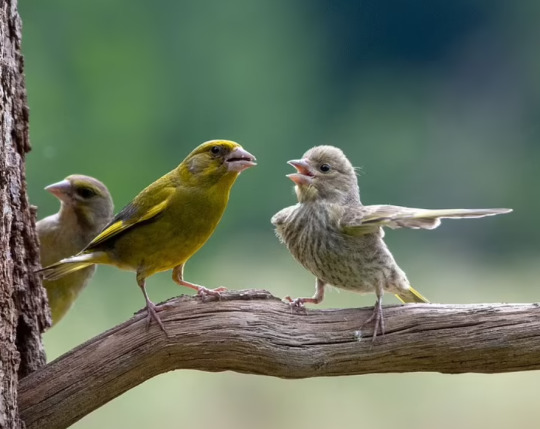
Dispute by Jacek Stankiewicz from Kraków, Poland: 'I caught this scene while watching birds in the Bialowieza Forest. Young greenfinch was still fed by parents. However, from time to time birds looked like having argument. My friends interpret this scene in two ways: A young naughty kid is arguing with a parent. Or one kid is reporting to the parent that its brother did something wrong: "Look he has broken the glass in the window"'

'Excuse me sir but I think you're a little too young to be smoking' by Dakota Vaccaro from Victor, United States: 'While I was working deep in the Virginian woods, a family of grey foxes took up residence under the deck of the abandoned cottage next to my work housing. One day while practicing their hunting skills on bits of moss and branches, one of the kits lunged at a small chunk of wood and started rolling around with his prize. Tired after his hunt the kit lounged on his belly still holding the wood in his mouth which gave the strong resemblance of a cigar. I was very envious of the kit at this moment cause who wouldn't want to just lay around all day relaxing'

The Rainforest Dandy by Delphine Casimir from Brussels, Belgium: 'This picture was taken in the monkey forest in Ubud, Bali. This place is a crazy place where monkeys are king! Sometimes they give a show, sometimes they climb on you to look for fleas or steal the piece of biscuit you are trying to eat'
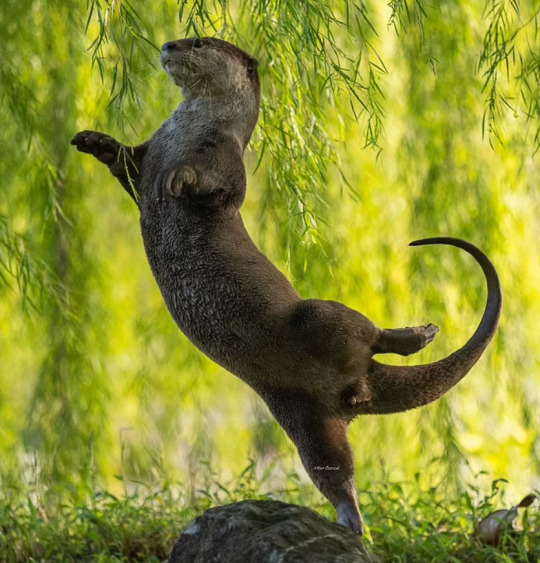
Otter Ballerinas by Otter Kwek from Singapore: 'An arabesque smooth coated otter'
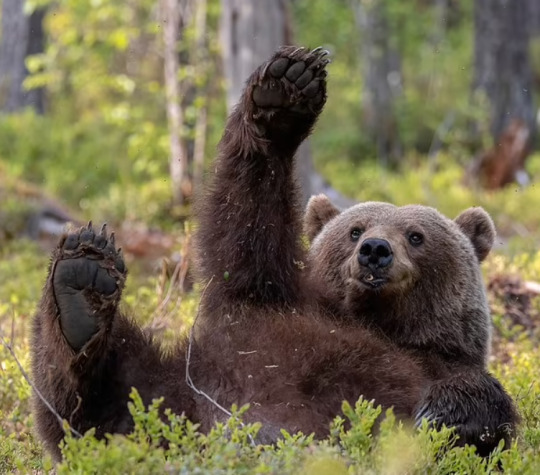
Picture me! Picture me!! by Dikla Gabriely from Yokneam, Israel: 'A brown bear in Finland who definitely did everything to make me pay attention to him and focus on him and not the other bears'

Boing! by Lara Mathews from Melbourne, Australia: 'Taken at Westerfolds Park, a beautiful and surprisingly wild pocket of land in the eastern suburbs of Melbourne, famous for its kangaroo population. The mob was enjoying some morning sunshine when this joey decided to get silly and try his hand at boxing'
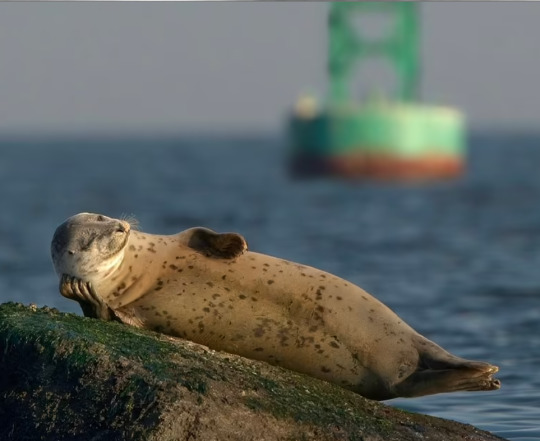
Living the Moment by Kawing Chiu from Staten Island, United States: 'Relax, lay back and enjoy the warm sun... This seal is scratching its face and it is seen lying on the side while his head is supported by his flipper. This image makes the seal like the reclining Buddha statue'
28K notes
·
View notes
Text

BRUSSELS — Today, the Belgian Federal government’s Council of Ministers approved a legislative proposal for a ban on the import of hunting trophies of endangered animal species, put forth by Zakia Khattabi, Minister of Climate, the Environment, Sustainable Development and Green Deal.
The Minister’s preliminary draft bill follows the Federal Parliament of the Kingdom of Belgium’s unanimous vote in March 2022 in support of a resolution demanding that the government put the brakes on the issuance of trophy import permits for a broad array of threatened and endangered species.
This resolution protects species such as the hippopotamus, Southern white rhinoceros, African savannah elephant, lion, polar bear and argali sheep killed for sport.
The scope of the resolution also extends to all species listed in Annex A, along with certain species in Annex B of the European Regulation 338/97 on the protection of species of wild fauna and flora.
Member of Parliament Kris Verduyckt (Vooruit, Flemish Socialists), initiator of the legislative proposal to ban hunting trophy imports in 2020 and proposer of the aforementioned resolution, said:
“I am glad that this hard work is paying off. Minister Khattabi is now fully translating my proposal into a bill and the entire Council of Ministers approves it.
It’s time we really started protecting endangered species. Trophy hunters prefer to kill the largest and strongest animals, the loss of which contributes to the disruption and decline of animal populations.”
The European office of animal protection charity Humane Society International, a long-time vocal advocate against the import of endangered species’ trophies, lauded the government’s decision.
Ruud Tombrock, executive director for HSI/Europe said:
“We welcome the fact that the unanimous resolution of Parliament has been translated into a legislative measure and look forward to studying the details of the legislation once published.
Belgium is leading the way for other countries in Europe already listening to calls from their citizens to consign the import of hunting trophies to history.
The next step should be an EU-wide ban on the import of hunting trophies from endangered and protected species, again reflecting the views of citizens across member states in the European Union.”
Over the past 16 months, HSI/Europe has worked with MPs to ensure that the unanimous resolution of Parliament was translated into legislation.
Today’s approval is the culmination of this campaign.
MPs from different political parties have maintained pressure on Environment Minister Khattabi.
A recent response to a parliamentary question from MP Jan Briers (CD&V, Flemish Christian democrats) revealed that the Ministry had only stopped issuing permits for importing animal trophies since mid-March 2023, a delay which outraged many MPs.
This landmark decision by the Belgian government echoes the strongly held views of its people.
A 2020 survey by Ipsos commissioned by HSI/Europe showed that 91% of Belgians oppose trophy hunting and 88% support a prohibition on importing any kind of hunting trophy at all.
This sentiment is not limited to Belgium but is resonating across the European continent.
A 2023 pan-European poll conducted by Savanta in all 27 EU Member States on behalf of HSI/Europe laid bare the widespread public rejection of trophy hunting.
A striking 83% of respondents stood firm against this practice, with just 6% in favor.
The vast majority is expecting strong measures to be taken against trophy hunting, with a compelling majority (74%) rallying behind a national import ban and similar support for an EU-wide ban (73%).
These survey results underscore a profound and growing public concern across Europe, spotlighting the urgency and importance of wildlife conservation and the protection of threatened species.
Today, Belgium has echoed the urgent European call to action against trophy hunting, joining the ranks of countries like the Netherlands, France and Finland, which have each implemented various degrees of bans and restrictions on the practice of import of hunting trophies.
Momentum against trophy hunting is accelerating across the continent, with nations including the UK, Germany, Italy, and Poland now also involved in active discussions to impose bans at varying stages of progress.
Facts on trophy hunting:
• The Netherlands introduced a trophy hunting ban for more than 200 species in May 2016 on the Annex A of European Regulation 338/97, on the protection of species of wild fauna and flora by regulating trade therein, and of species in danger of extinction.
The import ban also applies to the following Annex B species: white rhinoceros, hippopotamus, African elephant, mouflon (wild sheep from the Caucasus), lion and polar bear.
A total of 200 animal species are affected by the import licenses ban.
• France implemented a ban on the import of lion-hunting trophies in 2015.
In 2023, a Bill proposal for registration aimed at “stopping the issuance of import permits for hunting trophies of certain endangered species was tabled.
•The import of hunting trophies into Finland is restricted since June 2023.
The new Nature Conservation Act includes a provision that prohibits the import of individual animals or their parts from the most endangered species worldwide, which are threatened by international trade as trophies from countries outside the EU.
• In the United Kingdom in March 2023, British lawmakers approved a ban on the import of animal hunting trophies covering 6,000 endangered species, which makes it one of the toughest in the world.
The legislation is now being debated in the House of Lords.
• In Germany, the Minister of the Environment, Steffi Lemke (The Greens), announced that she intends to restrict the import of hunting trophies from protected animal species.
Germany terminated the Country’s membership in the International Council for Game and Wildlife Conservation (CIC) in 2022.
• In Italy in 2022, a bill aimed at banning the import, export and re-export, to and from Italy, of hunting trophies obtained from animals that are protected by CITES, was presented.
After the fall of the government and the elections in 2023, the same bill was tabled again in parliament.
• In Poland, a bill sponsored by the deputy chairperson of the Sejm, the lower chamber of the parliament, reached committee stage discussion this month and is scheduled for further progress in August 2023.
• Trophy hunting of endangered species poses a severe threat to conservation efforts and the world’s natural heritage.
Trophy hunters prefer to kill the largest, strongest animals, whose loss causes declines in population.
The affected species, such as African elephants, lions, rhinoceros, and leopards, among others, are already facing the risk of extinction and play crucial roles in maintaining healthy ecosystems and biodiversity.
The loss of these iconic animals not only disrupts delicate ecological balances but also erodes cultural and historical significance.
Many species play important roles in their ecosystems. Their removal can have cascading effects on other wildlife, vegetation, and the overall health of the ecosystem.
• The EU is the second biggest importer of hunting trophies after the United States, as indicated in a report by Humane Society International/Europe from 2021, with an average of 3000 trophies imported in the period between 2014 and 2018.
• The top 10 species imported into the EU as trophies are:
Hartmann’s mountain zebra (Equus zebra hartmannae) (3.119), Chacma baboon (1.751), American black bear (Ursus americanus) (1.415), brown bear (1.056), the African elephant (952), African lion (Panthera leo) (889), African leopard (Panthera pardus) (839), hippopotamus (Hippopotamus amphibius) (794), caracal (Caracal caracal) (480), and red lechwe (Kobus leche) (415).
• The EU was the largest importer of cheetah (Acinonyx jubatus) trophies with 297 cheetah trophies imported into the EU during the study period.
• Belgium is the 13th largest hunting trophy importer of internationally protected species in Europe
• Shortly before the vote of the resolution last year, Animal Rights Belgium, another organisation campaigning against the import of hunting trophies in Belgium, delivered a petition with 37,000 signatures supporting the ban to the Federal Environment Minister, Zakia Khattabi.
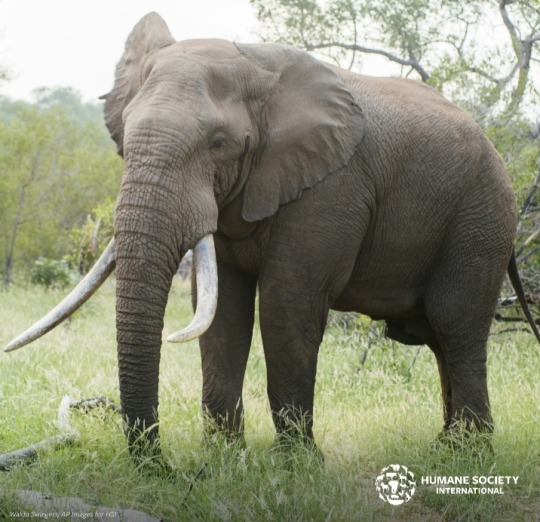
💛🙌💛
#Ban on Hunting Trophy#Protect Wildlife#Belgium#endangered animals#endangered species#European Regulation 338/97#Kris Verduyckt#Zakia Khattabi#Council of Ministers#Humane Society International#Ruud Tombrock#HSI/Europe#HSI#European Union#wildlife conservation#Nature Conservation Act#International Council for Game and Wildlife Conservation (CIC)#Animal Rights Belgium#save animals#animals#wildlife
11 notes
·
View notes